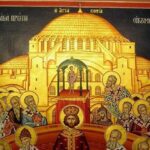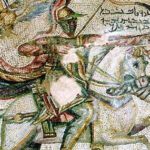The Trinity is one of the most profound mysteries of the Christian faith. God is one (Deuteronomy 6:4; ’The Lord is One’), yet we also worship three distinct Persons—Father, Son and Holy Spirit—at the same time.
Christian apologists, preachers and Sunday school teachers have struggled to illustrate and explain this union without straying into heresy. Some try to represent the oneness of God by using water—i.e. God is one and three in the same way that water can take the form of solid, liquid or gas. Other analogies liken God to things like eggs where there are different parts (e.g. yolk, white and shell) within one whole. Images of three-leaf clovers, triangles, and even cricket stumps, work the same way: one object is made up of three different, identifiable elements.
Yet, despite their ingenuity, these popular trinitarian analogies all fail in important ways.
Despite their ingenuity, these popular trinitarian analogies all fail in important ways.
For example, trying to represent God through water fails, because water doesn’t exist in its different states at the same time.[1] It’s either steam or liquid or ice—one substance manifesting itself in different ways. Yet God the Father, Son and Holy Spirit don’t change into each other like that; they exist together eternally. The water analogy resembles a heresy called modalism (or Sabellianism) and the plurality of the Trinity is lost.
Moreover, the attempts to represent God through things like eggs, leaves, triangles or cricket wickets fail because each part is not a full expression of the one. One leaf of a clover is not a full clover, and an egg yolk is not a full egg. These analogies imply that the Father, Son and Holy Spirit together make up God—each of the persons of the Trinity is just a part of God—only becoming fully God when they are together.
Help from the Olympiad
Yet instead, I wonder if something from the Olympic Games offers a better and more robust analogy: the gold medal analogy.
When Australia won gold in the women’s 4x100m freestyle swimming gold medal relay team there were four gold medals awarded to Bronte Campbell, Meg Harris, Emma Mckeon and Cate Campbell. We count four distinct gold medals here. Yet if we look at the Olympic Games medal tally, Australia was awarded just one gold medal for the event. One gold medal yet four gold medals. Four in one!
The four medals aren’t each a quarter of the one gold medal. They are the same medal.
This analogy overcomes the challenge of denying the plurality of the Trinity: there really are four distinct personal medals; the one gold medal on the medal tally exists at the same time as the four individual gold medals.
It also overcomes the danger of parts–trinitarianism. The four medals aren’t each a quarter of the one gold medal (they are just the same as any medal given to individual victors). They are the same medal. Just as God the Father and God the Son and God the Holy Spirit are three persons but one God.
One final point in the analogy’s favour: there aren’t five physical medals given out after a relay. The one medal that the four medals are isn’t given out at the podium. It is an abstract thing. It only appears around the necks of the four competitors. This too is a bit like the Trinity. There isn’t an extra Person lurking behind the three Persons. The one divine nature only exists as Father, Son and Spirit.
Imperfect but Useful
Nevertheless, it’s not a completely perfect analogy (could any analogy of the heart of the godhead possibly be?) For example, the persons of the Trinity are not interchangeable team-mates. They come in an order: the Son and the Spirit eternally come from the Father. The divine nature begins (logically, not in time) with him.
Perhaps the weakness of the analogy at this point can be mitigated by recognising that, even in team sports, where each person gets the same medal, there are still differences in role. There are team captains; there are orders in a relay. Different team-members participate in the same victory in different ways appropriate to their place in the team—just as, for us, there is:
… one God, the Father, from whom are all things and for whom we exist, and one Lord, Jesus Christ, through whom are all things and through whom we exist. (1Corinthians 8:6)
So the medal analogy is imperfect, but it might be helpful. It overcomes many of the weaknesses of the more popular Trinity analogies. It reminds us that even our ordinary world has some features that are strange in a similar way that the Trinity is strange—and, accordingly, that the oneness and threeness of our God aren’t quite as inconceivable as some people say they are.
Perhaps it might help us to meditate on our great God as we watch the Olympics. As we watch relay events and see four medals awarded for one medal, we can consider how this points, in a small way, to the infinitely greater glory (and victory) of our true God: Father, Son and Spirit.
[1] At least in our ordinary experience. Scientists may wish to argue that there is a triple-state in which the three occur together, but that is a mysterious condition that is foreign to most of us.















